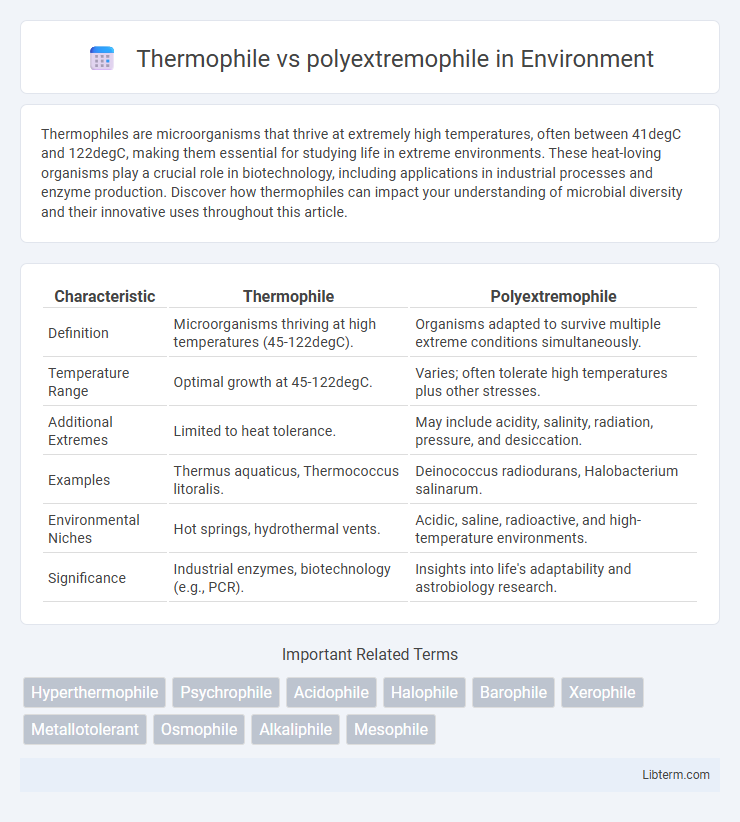Thermophiles are microorganisms that thrive at extremely high temperatures, often between 41degC and 122degC, making them essential for studying life in extreme environments. These heat-loving organisms play a crucial role in biotechnology, including applications in industrial processes and enzyme production. Discover how thermophiles can impact your understanding of microbial diversity and their innovative uses throughout this article.
Table of Comparison
| Characteristic | Thermophile | Polyextremophile |
|---|---|---|
| Definition | Microorganisms thriving at high temperatures (45-122degC). | Organisms adapted to survive multiple extreme conditions simultaneously. |
| Temperature Range | Optimal growth at 45-122degC. | Varies; often tolerate high temperatures plus other stresses. |
| Additional Extremes | Limited to heat tolerance. | May include acidity, salinity, radiation, pressure, and desiccation. |
| Examples | Thermus aquaticus, Thermococcus litoralis. | Deinococcus radiodurans, Halobacterium salinarum. |
| Environmental Niches | Hot springs, hydrothermal vents. | Acidic, saline, radioactive, and high-temperature environments. |
| Significance | Industrial enzymes, biotechnology (e.g., PCR). | Insights into life's adaptability and astrobiology research. |
Introduction to Thermophiles and Polyextremophiles
Thermophiles are microorganisms that thrive at high temperatures, typically between 45degC and 122degC, and are commonly found in geothermal environments such as hot springs and hydrothermal vents. Polyextremophiles are a subclass of extremophiles that withstand multiple extreme conditions simultaneously, including elevated temperature, acidity, salinity, and radiation. Understanding the unique adaptations of thermophiles and polyextremophiles provides insight into microbial survival strategies and potential biotechnological applications in industries like biofuels and pharmaceuticals.
Defining Thermophiles: Heat-Loving Microorganisms
Thermophiles are heat-loving microorganisms that thrive at temperatures between 41degC and 122degC, often found in environments like hot springs, hydrothermal vents, and compost heaps. Unlike polyextremophiles, which endure multiple extreme conditions such as high temperature, acidity, or salinity, thermophiles specialize primarily in heat tolerance due to unique adaptations in their proteins and cellular membranes. Their ability to stabilize enzymes at high temperatures makes thermophiles crucial for biotechnological applications, including PCR polymerase enzymes in molecular biology.
What are Polyextremophiles? Multitasking Survivalists
Polyextremophiles are microorganisms that thrive in multiple extreme environments simultaneously, such as high temperature, acidity, salinity, or radiation, showcasing remarkable adaptability. Unlike thermophiles that specialize in surviving high temperatures, polyextremophiles multitask by enduring a combination of stressors challenging to most life forms. This capability highlights their unique biochemical mechanisms and potential applications in biotechnology and astrobiology.
Key Differences: Thermophiles vs. Polyextremophiles
Thermophiles thrive in high-temperature environments typically between 41degC and 122degC, relying on specialized enzymes to maintain cellular function under heat stress. Polyextremophiles endure multiple extreme conditions simultaneously, such as high temperature, salinity, pH, or radiation, displaying complex adaptations beyond thermal tolerance alone. The key difference lies in thermophiles' singular adaptation to heat, whereas polyextremophiles possess multifaceted mechanisms to survive diverse and combined environmental extremes.
Molecular Adaptations in Thermophiles
Thermophiles exhibit molecular adaptations such as heat-stable enzymes with increased ionic bonds and hydrophobic cores that maintain protein structure at high temperatures. Their DNA features higher GC content and specialized DNA-binding proteins like histone-like proteins to prevent denaturation. In contrast, polyextremophiles combine these adaptations with mechanisms for multiple stresses, but thermophiles' molecular stability strategies are primarily optimized for thermal resilience.
Unique Survival Strategies of Polyextremophiles
Polyextremophiles exhibit unique survival strategies by simultaneously enduring multiple extreme conditions such as high temperature, acidity, salinity, and radiation, unlike thermophiles which specialize primarily in thriving at elevated temperatures. Their cellular mechanisms include robust DNA repair systems, specialized membrane lipids, and versatile enzymes that maintain functionality under combined stresses. These adaptations enable polyextremophiles to inhabit some of the most inhospitable environments on Earth, such as acidic hot springs and deep-sea hydrothermal vents.
Environmental Habitats: Where They Thrive
Thermophiles thrive in extreme heat environments such as hot springs, hydrothermal vents, and geothermal soils, where temperatures range from 45degC to over 80degC. Polyextremophiles endure multiple extreme conditions simultaneously, inhabiting harsh habitats like acidic hot springs, saline deserts, and acidic mines with variations in temperature, pH, salinity, and pressure. These diverse environmental adaptations enable thermophiles and polyextremophiles to colonize unique ecological niches inaccessible to most life forms.
Industrial and Biotechnological Applications
Thermophiles thrive in high-temperature environments, making them valuable for industrial processes such as biofuel production, waste treatment, and enzyme synthesis that require heat-stable catalysts. Polyextremophiles withstand multiple extreme conditions like extreme pH, salinity, and temperature, offering robust enzymes for biotechnological applications including pharmaceuticals, bioremediation, and molecular biology techniques. Both microbes provide unique biomolecules that enhance efficiency, stability, and sustainability in industrial and biotechnological sectors.
Recent Research and Discoveries
Recent research highlights thermophiles thriving in high-temperature environments up to 122degC, with enzymes like Taq polymerase revolutionizing molecular biology. Polyextremophiles exhibit resilience to multiple extremes, such as radiation, acidity, and salinity, expanding the understanding of life's adaptability. Novel genomic sequencing techniques reveal unique metabolic pathways enabling survival under combined stressors, opening new avenues for biotechnological applications.
Future Perspectives in Extremophile Studies
Thermophiles and polyextremophiles offer unique insights into resilience mechanisms under extreme conditions, driving advancements in biotechnology and astrobiology. Future perspectives in extremophile studies emphasize genome editing, synthetic biology, and metagenomics to harness their metabolic pathways for industrial enzymes, bioenergy production, and novel pharmaceuticals. Expanding research on their adaptive strategies promises breakthroughs in understanding life's limits and potential extraterrestrial habitats.
Thermophile Infographic

 libterm.com
libterm.com